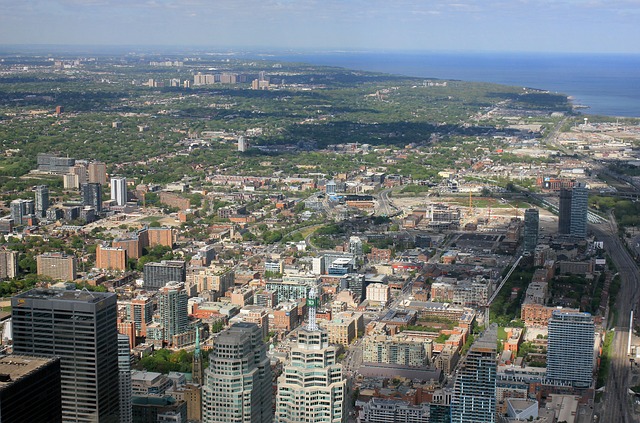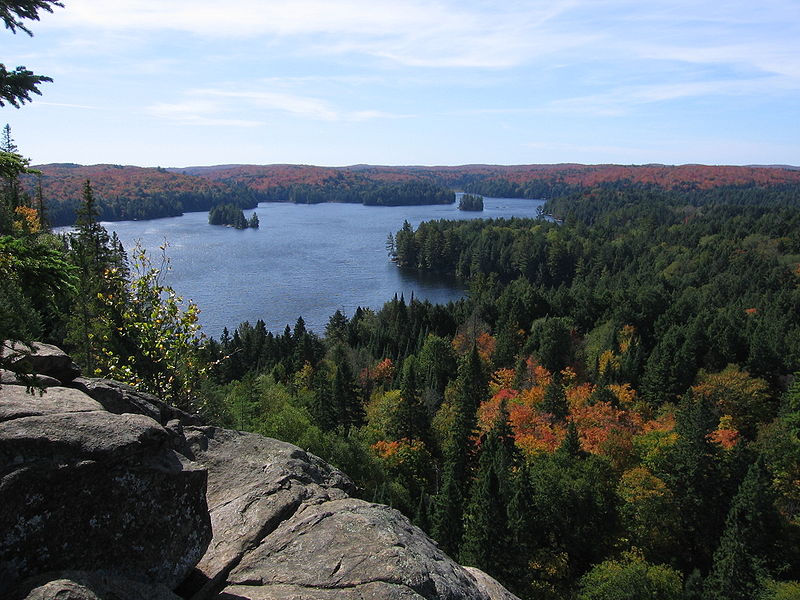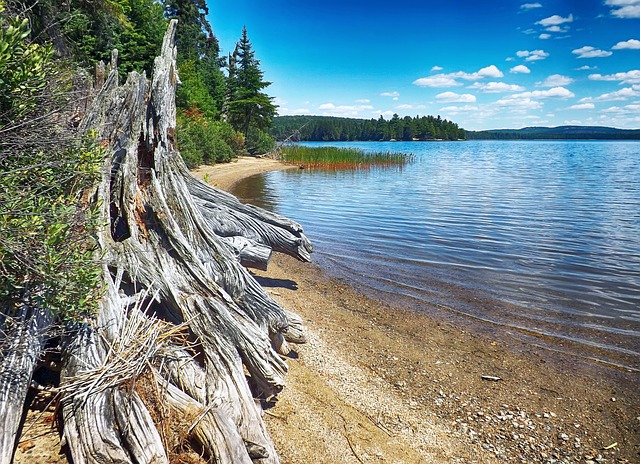Ontario’s economy had its beginnings in the pursuit of natural resources: fur, timber and minerals. The province’s many rivers and lakes, particularly the Great Lakes, made for natural transportation routes. As the population of Ontario increased, people started new industries and surveyed, cleared and farmed the rich agricultural land.
The economy of Ontario is rich and diversified. Ontario is the largest economy in Canada, its GDP being nearly twice that of neighbouring Quebec, the second largest economy. The Ontarian economy is highly influenced, and run by the service sector, though manufacturing also plays an important role.
Toronto, the capital of Ontario, is the centre of Canada’s financial services and banking industry. Neighbouring cities in the Greater Toronto Area like Brampton, Mississauga and Vaughan are large product distribution and IT centres, in addition to having various manufacturing industries. The information technology sector is also important, particularly in the Silicon Valley North section of Ottawa, as well as the Waterloo Region. Government is the single largest employer in the National Capital Region employing hundreds of thousands. Hamilton is the largest steel manufacturing city in Canada, and Sarnia is the centre for petrochemical production. Construction employs at least 7% of the work force, this sector has slowed down somewhat after a ten year plus boom.
CN Tower in Toronto is the world’s 3rd tallest free-standing structure and has the 2nd highest public observation level on Earth. In 1995, the CN Tower was declared one of the modern Seven Wonders of the World by the American Society of Civil Engineers. It has been the tallest free-standing structure on land in the world for 31 years.
Mining and the forest products industry, notably pulp and paper, are vital to the economy of Northern Ontario. More than any other region, tourism contributes heavily to the economy of Central Ontario, peaking during the summer months owing to the abundance of fresh water recreation and wilderness found there in reasonable proximity to the major urban centres. At other times of the year, hunting, skiing and snowmobiling are popular. This region has some of the most vibrant fall colour displays anywhere on the continent, and tours directed at overseas visitors are organized to see them. Tourism also plays a key role in border cities with large casinos, among them Windsor, Cornwall, Sarnia and Niagara Falls, which attract many U.S. visitors.
Today, northern Ontario’s economy is still highly dependent on natural resources while southern Ontario, with its proximity to the enormous U.S. market, is heavily industrialized. Ontario is part of the North American manufacturing heartland and is favourably located to serve major Canadian and U.S. markets. 106 million people live within a day’s trucking distance of Toronto with a personal income totaling US $2.7 trillion. However, in the 21st century, more Ontarians are employed in service industries than on assembly lines. Ontario’s highly diversified economy offers excellent opportunities in all sectors ranging from automotive, plastics, aerospace to information and telecommunications technology and the life sciences.
ONTARIO FACT SHEET OF JANUARY 2012
Economy, 2010
| GDP ($ millions, nominal) |
612,494 |
| % of Canada |
37.7 |
| Personal income ($ millions) |
500,048 |
| % of Canada |
39.1 |
| Personal income per capita ($) | |
| Ontario |
37,803 |
| Canada |
37,506 |
| CPI inflation (2010) |
2.5% |
| Unemployment rate (2011) |
7.8% |
Per Cent Distribution of GDP, 2010
| Goods |
24.2 |
| Of which: Manufacturing |
15.1 |
| Services |
75.4 |
Top Five International Export Markets, 2010 (%)
| United States |
78.8 |
| United Kingdom |
7.6 |
| Norway |
1.5 |
| Mexico |
1.2 |
| China |
1.0 |
Top Five International Exports, 2010 (%)
| Motor vehicles & parts |
31.9 |
| Precious metals & stones |
11.1 |
| Mechanical equipment |
9.5 |
| Electrical machinery |
4.8 |
| Plastic products |
3.6 |
Total Trade, 2010 ($ millions)
| Exports |
304,424 |
| Imports |
315,318 |
| Trade balance |
-10,894 |
Top Five International Import Suppliers, 2010 (%)
| United States |
57.6 |
| China |
10.7 |
| Mexico |
7.4 |
| Japan |
3.9 |
| Germany |
1.9 |
Top Five International Imports, 2010 (%)
| Motor vehicles & parts |
20.2 |
| Mechanical equipment |
14.7 |
| Electrical machinery |
12.2 |
| Precious metals & stones |
4.4 |
| Pharmaceutical products |
3.9 |
ONTARIO′S ECONOMY HIGHLIGHTS
- Government-projected 2012 real GDP growth – 1.7%
- Private-sector average projected 2012 real GDP growth – 1.9%
- Government-projected 2013 real GDP growth – 2.2%
- Private-sector average projected 2013 real GDP growth – 2.3%
- Net new jobs created since October 2003 – 508,900
- Net new jobs created since recessionary low in June 2009 – 299,300
- The unemployment rate is projected to fall to 6.7% in 2015
Ontario′s Finances
- 2011-12 deficit – $15.3 billion, $1 billion lower than forecast in the 2011 Budget.
- 2011-12 deficit as a share of GDP is projected to be 2.4%
- By maintaining a low rate of growth in spending and building on a record of overachieving deficit targets laid out in the 2010 and 2011 Budgets, the government will balance the budget by 2017-18.
MANUFACTURING
An abundance of natural resources, excellent transportation links to the American heartland and the inland Great Lakes making ocean access possible via container ships, have all contributed to making manufacturing the principal industry, found mainly in the Golden Horseshoe region, which is the largest industrialized area in Canada. Important products include motor vehicles, iron, steel, food, electrical appliances, machinery, chemicals, and paper.
Ontario has Chrysler plants in Windsor and Bramalea, two GM plants in Oshawa and one in Ingersoll, a Honda assembly plant in Alliston, Ford plants in Oakville and St. Thomas and Toyota assembly plants in Cambridge and Woodstock. As of 2010, Ontario is the largest producer of automobiles in North America.
However, as a result of steeply declining sales, in 2005, General Motors announced massive layoffs at production facilities across North America including two large GM plants in Oshawa and a drive train facility in St. Catharines resulting in 8,000 job losses in Ontario alone. In 2006, Ford Motor Company announced between 25,000 and 30,000 layoffs phased until 2012; Ontario was spared the worst, but job losses were announced for the St. Thomas facility and the Windsor Casting plant. However, these losses will be offset by Ford’s recent announcement of a hybrid vehicle facility slated to begin production in 2007 at its Oakville plant and GM’s re-introduction of the Camaro which will be produced in Oshawa. On December 4, 2008 Toyota announced the grand opening of the RAV4 plant in Woodstock, and Honda also has plans to add an engine plant at its facility in Alliston. Despite these new plants coming online, Ontario has been hurt by layoffs created cause by the global recession, its unemployment rate is steadied at 9.2% (as of Jan. 2010) vs. roughly 6% in 2007.
AGRICULTURE
Once the dominant industry, agriculture occupies a small percentage of the population but still a large part of Southern Ontario’s land area. The number of farms has decreased from 68,633 in 1991 to 59,728 in 2001, but farms have increased in average size, and many are becoming more mechanized. Cattle, small grains and dairy were the common types of farms in the 2001 census.
The fruit, grape and vegetable growing industry is located primarily on the Niagara Peninsula and along Lake Erie, where tobacco farms are also situated. The Corn Belt covers much of the southwestern area of the province extending as far north as close to Goderich. Apple orchards are a common sight along the southern shore of Georgian Bay near Collingwood and along the northern shore of Lake Ontario near Cobourg. Tobacco production, centred in Norfolk County has decreased leading to an increase in some other new crop alternatives gaining popularity, such as hazelnuts and ginseng. The Ontario origins of Massey Ferguson, once one of the largest farm manufacturers in the world, indicate the importance agriculture once had to the Canadian economy.
Southern Ontario’s limited supply of agricultural land is going out of production at an increasing rate. Urban sprawl and farmland severances contribute to the loss of thousands of acres of productive agricultural land in Ontario each year. Over 2,000 farms and 150,000 acres (61,000 ha) of farmland in the GTA alone were lost to production in the two decades between 1976 and 1996. This loss represented approximately 18% of Ontario’s Class 1 farmland being converted to urban purposes. In addition, increasing rural severances provide ever-greater interference with agricultural production.
The 500,000, or so, acres (200,000ha) comprising the black peat soil Holland Marsh, located just south of Lake Simcoe and near the town of Bradford West Gwillimbury (35mi (56km) north of Toronto) continues to be Canada’s premier vegetable production center.
ENERGY
Ontario’s rivers, including its share of the Niagara River, make it rich in hydroelectric energy. In 2009 Ontario Power Generation generated 70% of the electricity of the province, of which 51% is nuclear, 39% is hydroelectric and 10% is fossil fuel derived. Ontario is home to Niagara Falls, which supplies a large amount of clean, hydroelectric energy for the province.
The Bruce Nuclear Generating Station, the second largest nuclear power plant in the world, is also in Ontario and uses 8 CANDU reactors to power the province with clean, reliable energy.
Much of the newer power generation coming online in the last few years is natural gas or combined cycle natural gas plants. OPG is not however responsible for the transmission of power, which is under the control of Hydro One. Despite its diverse range of power options, problems related to increasing consumption, lack of energy efficiency and aging nuclear reactors, Ontario has been forced in recent years to purchase power from its neighbours Quebec and Michigan to supplement its power needs during peak consumption periods.
Coal burning power stations were built near Toronto and Windsor in the early 1950s. In the 1960s, Ontario turned to nuclear power. In 1962 the HEPC and Atomic Energy of Canada Limited started operating a 25-megawatt Nuclear Power Demonstrator, and in 1968 they brought the 200-megawatt Douglas Point Nuclear Generating Station into service. This was followed by the Pickering Nuclear Generating Station in 1971, the Bruce Nuclear Generating Station in 1977, and the Darlington Nuclear Generating Station in 1989. In 1974, toward the beginning of this expansion, the HEPC was renamed Ontario Hydro, which had long been its informal name. Eventually, Pickering grew to eight 540 MW nuclear reactors, Bruce to eight 900+ MW reactors, and Darlington to four 935 MW units. In the 1990s, the enormous debt from building nuclear power stations, combined with lower than expected reliability and life span, became a political issue.
Ontario is working to be a North American leader in renewable energy by using such energy sources as wind, solar, hydro, biomass and biogas. As the steward of the province’s natural resources and the approximately 87% of Ontario that is Crown land, the Ministry of Natural Resources has a key role to play in facilitating renewable energy development. The Green Energy and Green Economy Act, 2009 (GEA), takes a two-pronged approach to creating a renewable-energy economy. The first is to bring more renewable energy sources to the province and the second is the creation of more energy efficiency measures to help conserve energy. The bill would also appoint a Renewable Energy Facilitator to provide “one-window” assistance and support to project developers in order to facilitate project approvals. The approvals process for transmission projects would also be streamlined and for the first time in Ontario, the bill would enact standards for renewable energy projects. Homeowners would have access to incentives to develop small-scale renewables such as low- or no-interest loans to finance the capital cost of renewable energy generating facilities like solar panels.
NATURAL RESOURCE INDUSTRIES
Ontario has been blessed with an abundance of natural resources. A wide range of industries make use of these resources. Resource industries create jobs and prosperity, but we must always make sure that these resources will be available for future generations.
Forest Industry
With about 85 billion trees ranging from the leafy hardwood species of the south to the softwood conifer species of the north, Ontario’s landscape is dominated by forests. By making use of this resource, the forest industry has long been a key part of Ontario’s economy. It supports almost 200,000 direct and indirect jobs in over 260 communities across the province. The value of Ontario’s forestry sector products was $14 billion in 2008. The industry makes such products as pulp and paper, veneer, engineered wood, furniture, cabinets and more. Ontario’s forest industry is a world leader in sustainable forestry.
Aggregate Operations
Aggregate resources such as stone, sand and gravel are a key component of the $37 billion construction industry. They also contribute to the concrete, cement, glass, glass products, pharmaceutical and medicine manufacturing industries. Ontario produced about 153 million tonnes of aggregates in 2009.
Fishing and Aquaculture
Commercial fishing has been part of Ontario’s culture and heritage for many years. Ontario’s is the largest freshwater commercial fishery in Canada. In 2008, it is estimated that once the fish has been processed and sent to food stores and restaurants in Ontario, the U.S. and around the world, the industry’s contribution to Ontario’s economy was approximately (range) $180 million to $215 million (Canadian) dollars. There are more than 500 active commercial fishing licences in Ontario.
In 2008, Ontario’s commercial licence holders caught nearly 14,808 metric tonnes (32.6 million pounds) of fish. The dockside, or wholesale, value of their catch will vary from year to year, however in 2008 that figure was $29.2 million. (Dockside value refers to the price paid for the fish as it comes off the boat and before it is processed for people to eat.)
Ontario has the largest recreational fishing industry with over 1.2 million anglers and an economic contribution of $2.4 billion annually. Popular species for anglers include muskellunge, walleye and bass. Aquaculture, or fish farming, also makes a contribution of about $65 million to the provincial economy annually. The Lake Erie commercial fishery accounts for about 80% of the value of commercial fishing on the Great Lakes.
Trapping
Trapping of furbearing animals is one of the oldest activities in Ontario. The province is one of the world’s leading suppliers of wild fur, and trappers pursue a wide range of species, including beaver, mink, muskrat and raccoon. Wildlife is a renewable resource that can replenish itself. Ontario’s fur management program is based on sound management to ensure long-term social and economic benefits.
Oil and Gas Operators
Ontario’s crude oil and gas reservoirs continue to help power the province. They supply about one per cent of our domestic oil and natural gas consumption each year with an annual value to the economy of $100 to $150 million. About 50 new oil and gas wells are drilled in southern Ontario annually. Underground space created by solution mining of salt, as well as oil and gas production, is a renewable resource used for temporary storage of natural gas and high-value liquid hydrocarbons worth more than $3 billion.
Mining
Mining has long been one of the pillars of Ontario’s economy. The province’s mines provide such minerals as gold, nickel, cobalt, platinum group metals and more. While the Ministry of Northern Development, Mines and Forestry is the lead ministry for the provincial minerals sector, Ontario Ministry of Natural Resources is responsible for parts of the Mining Act dealing with oil, natural gas and brine.
Ontario continued to be Canada’s leading jurisdiction for the production of non-fuel minerals, and a major player in the world. The province’s mineral production in 2009 was valued at $9.6 billion, with its 27 metal mines generating $6.6 billion for the economy.
Ontario led the country in exploration expenditures in 2009 with $469 million and is expected to lead again for the third time in a row in 2010. Active mining claim units remained strong in 2009 reaching 336,000.
In March 2009, Ontario joined the global stage as one of a few select countries that feature all the elements of the diamond industry—from mining to retailing – with the establishment of the Diamond Bourse of Canada. Located in Toronto, the Bourse provides a safe and secure venue for diamond dealers to buy and sell rough and polished diamonds while offering its members increased efficiency, cost savings and credibility in their international diamond dealings. The Diamond Bourse of Canada is an industry led and member supported initiative.
Ontario’s first diamond cutting and polishing facility located in Sudbury, opened in August, 2009. On a yearly basis, the facility will cut and polish an estimated $25 million worth of rough stones derived from DeBeers Canada’s Victor mine located in the James Bay Lowlands, about 90km west of Attawapiskat.
Tourist Outfitters
People come from all over the world to experience the hunting, fishing and other outdoor opportunities available in Ontario. The province’s tourist outfitters help guests enjoy their experience to the fullest. They provide such services as access to licences, transportation, accommodation, outdoor gear and more.
TRANSPORTATION
Historically, the province has used two major east-west routes, both starting from Montreal in the neighbouring province of Quebec. The northerly route, which was pioneered by early French-speaking fur traders, travels northwest from Montreal along the Ottawa River, then continues westward towards Manitoba. Major cities on or near the route include Ottawa, North Bay, Sudbury, Sault Ste. Marie, and Thunder Bay. The much more heavily traveled southerly route, which was driven by growth in predominantly English-speaking settlements originated by the United Empire Loyalists and later other European immigrants, travels southwest from Montreal along the St. Lawrence River, Lake Ontario, and Lake Erie before entering the United States in Michigan. Major cities on or near the route include Kingston, Oshawa, Toronto, Mississauga, Kitchener-Waterloo, London, Sarnia, and Windsor. This route was also heavily used by immigrants to the Midwestern US particularly in the late 19th century. Most of Ontario’s major transportation infrastructure is oriented east-west and roughly follows one of these two original routes.
Roads
More than 16,500 centreline kilometres (10,253mi) of provincial highways link Ontario’s cities and towns, including the Queen Elizabeth Way (QEW) and the 400 series of highways. Highway 401 stretches 820km (510mi) from Windsor to the Quebec border, and is one of the busiest roads in the world. The segment of Highway 401 passing through Toronto is the busiest road in North America, and one of the widest and busiest in the world. One section in the Toronto area carries about 500,000 vehicles daily.
400-Series Highways make up the primary vehicular network in the south of province, and they connect to numerous border crossings with the U.S., the busiest being the Detroit–Windsor Tunnel and Ambassador Bridge (via Highway 401) and the Blue Water Bridge (via Highway 402). The primary highway along the southern route is Highway 401/Highway of Heroes, the busiest highway in North America and the backbone of Ontario’s road network, tourism, and economy, while the primary highways across the north are Highway 417/Highway 17 and Highway 11, both part of the Trans-Canada Highway. Highway 400/Highway 69 connects Toronto to Northern Ontario. Other provincial highways and regional roads inter-connect the remainder of the province.
Waterways
Ontario’s lakes and rivers have historically provided natural travelling and trade routes. Beginning in the 19th century, canals were built to link certain lakes and rivers, including the Welland and Rideau canals. The Trent-Severn Waterway and the Rideau Canal are no longer used for high-volume commercial purposes but are still very popular with recreational boaters.
The St. Lawrence Seaway, completed in 1959, makes it possible for freighters to travel between Thunder Bay and the Atlantic Ocean, carrying goods to and from overseas markets.
The Welland Canal is a ship canal that runs 42km (27.0mi) from Port Colborne Lake Erie to Port Weller on Lake Ontario. As part of the St. Lawrence Seaway, the canal allows ships to traverse the Niagara Escarpment and avoid Niagara Falls. Approximately 40,000,000 tones of cargo are carried through the Welland Canal annually by over 3,000 ocean and lake vessels. The completion of the Welland Canal made the Trent-Severn Waterway obsolete as a commercial traffic route for Great Lakes navigation.
The canal’s Lake Erie (southern) terminus, at Port Colborne, is 99.5m (326.5ft) higher in elevation than the Lake Ontario (northern) terminus at Port Weller. The canal comprises eight lift locks, each 24.4m (80ft) wide by 233.5m (766ft) long. Due to the Garden City Skyway, the maximum ship height allowed is 35.5m (116.5ft). All other crossings are movable bridges (lift or Bascule) or tunnels. The maximum permissible vessel length is 225.5m (740ft). It takes ships an average of 11 hours to traverse the canal’s length.
The Saint Lawrence Seaway, which extends across most of the southern portion of the province and connects to the Atlantic Ocean, is the primary water transportation route for cargo, particularly iron ore and grain. In the past, the Great Lakes and St. Lawrence River were also major passenger transportation routes, but over the past half century passenger travel has been reduced to ferry services and sightseeing cruises.
Railways
The railways were largely responsible for opening up northern Ontario, beginning in the 1880s when copper and nickel were discovered on the Canadian Pacific Railway (CPR) transcontinental route. Today, railways are important for both passenger and freight service.
Via Rail operates 480 trains in eight Canadian provinces (exceptions are Newfoundland and Labrador and Prince Edward Island) over a network of 14,000km (8,700mi) of track, almost all of which is owned and operated by Canadian National Railway – CN Rail.
Via Rail operates the inter-regional passenger train service on the Quebec City – Windsor Corridor, along with “The Canadian”, a transcontinental rail service from Toronto to Vancouver, and “The Lake Superior”, a regional rail service from Sudbury to White River. Additionally, Amtrak rail connects Ontario with key New York cities including Buffalo, Albany, and New York City. Ontario Northland provides rail service to destinations as far north as Moosonee near James Bay, connecting them with the south.
Freight rail is dominated by the founding cross-country and CP Rail companies, which during the 1990s sold many short rail lines from their vast network to private companies operating mostly in the south.
Regional commuter rail is limited to the provincially owned GO Transit, which serves a train/bus network spanning the Golden Horseshoe region, with its hub in Toronto. GO Transit carries nearly 55 million passengers annually which results in approximately 1.6 billion fewer kilometres of passenger car trips each year.
The Toronto Transit Commission (TTC) operates the province’s only subway and streetcar system, one of the busiest in North America. It was Canada’s first completed subway system, with the first line being built under Yonge Street, which opened in 1954 with 12 stations. Since then, the network has expanded to become Canada’s largest rapid transit rail network, encompassing four lines and 69 stations on 68.3km (42.4mi) of track. The subway system is a very popular mode of public transport in Toronto with an average of 942,600 passenger trips each weekday (as of 2009).
The O-Train Light rail line operates in Ottawa with expansion of the line and proposals for additional lines.
Air travel
Toronto Pearson International Airport is the largest and busiest airport in Canada handling over 30 million passengers per year. It is currently the 20th busiest airport by aircraft movements in the world. In 2008, it handled 32.3 million passengers and 429,262 aircraft movements. In 2006, the airport was selected as the best global airport by the UK-based Institute of Transport Management.
Lester B. Pearson International Airport is the primary hub for Air Canada, making it a major Star Alliance hub airport. It also serves as a hub for Air Canada Jazz, Air Georgian, Air Transat, Fedex Express, Sunwing Airlines and WestJet. The airport is operated by Greater Toronto Airports Authority as part of Transport Canada’s National Airports System and is one of eight Canadian airports with facilities for United States border preclearance.
Other important airports include Ottawa Macdonald-Cartier International Airport and Hamilton’s John C. Munro Hamilton International Airport, which is an important courier and freight aviation centre. Toronto/Pearson and Ottawa/Macdonald-Cartier form two of the three points in Canada’s busiest set of air routes (the third point is Montréal-Pierre Elliott Trudeau International Airport).
Most Ontario cities have regional airports, many of which have scheduled commuter flights from Air Canada Jazz or smaller airlines and charter companies – flights from the larger cities such as Thunder Bay, Sault Ste. Marie, Sudbury, North Bay, Timmins, Windsor, London, and Kingston feed directly into Toronto Pearson. Bearskin Airlines also runs flights along the northerly east-west route, connecting Ottawa, North Bay, Sudbury, Sault Ste. Marie, and Thunder Bay directly without requiring connections at Toronto Pearson.
Isolated towns and settlements in the northern areas of the province rely partly or entirely on air service for travel, goods, and even ambulance services (MEDIVAC), since much of the far northern area of the province cannot be reached by road or rail.
INVESTING IN EDUCATION, HEALTH, TRANSPORTATION AND JUSTICE
The Province has made large infrastructure investments in key sectors, including education, health, transportation and justice. To protect the progress Ontario has made, it is more important than ever to ensure all government programs and services are being delivered as efficiently and effectively as possible.
- Improving Ontario’s Schools: Since September 2003, more than 400 new schools have been built, creating 230,000 new spaces for elementary and secondary students. This includes the Dr. David Suzuki Public School, which uses innovative and energy-efficient technologies. Construction is currently planned or in progress for over 120 new schools. In addition, more than 18,000 school renewal projects have been completed, or are underway, through the Good Places to Learn initiative.
- Ontario is also investing in full-day kindergarten for four- and five-year-olds as part of the Province’s plan to build a well-educated workforce. To date, the Province has announced $420 million to help schools make room for full-day kindergarten. In September 2012, full-day kindergarten will be offered in close to 1,700 Ontario schools.
- Modernizing Postsecondary Facilities: Through the Knowledge Infrastructure Program, the federal and Ontario governments are investing $1.5 billion towards 49 college and university stimulus projects. The projects include redevelopment of the Sault College campus, a new instructional centre and lab complex at the University of Toronto’s Mississauga campus, a new facility to house the School of Medicine at Queen’s University, and a new fire and emergency response training centre at Lambton College. These and other provincial stimulus investments will help create over 36,000 new postsecondary spaces.
- Strengthening Health Care: Construction is complete or in progress for more than 100 major hospital projects, including 18 new hospitals. Completed projects include the North Bay Regional Health Centre, London Health Sciences Centre (Phase 1), Ottawa Regional Cancer Centre, Sunnybrook Health Sciences Centre, Peterborough Regional Health Centre and Sault Area Hospital. Health capital investments have also included funding to expand community services, improve cancer radiation equipment and add almost 9,000 new long-term care beds.
- Improving and Expanding Transit Service: Since 2003, the government has provided $10.8 billion to support public transit, compared to a total of $2.6 billion over the previous seven years. This increase has supported growth in GO Transit ridership of approximately 25 per cent since 2003, and 100 million more municipal transit trips, representing about 83 million car trips not taken on Ontario roads.
- Improving Ontario’s Highways: Ontario’s highway investments have expanded or rehabilitated over 5,500km of highways across the province since 2003, a distance roughly equivalent to driving from Ottawa to Whitehorse.
- Better Justice Facilities: Since 2003, the government has completed the following significant justice projects: the Durham Consolidated Courthouse (Oshawa), Roy McMurtry Youth Centre (Brampton) and a major renovation of the Renfrew County Consolidated Courthouse (Pembroke). In addition, five more large community safety and courthouse projects are in progress.
- Supporting Municipalities: Since 2003, the Province has provided municipalities with over $12 billion in infrastructure funding. These investments have helped municipalities to modernize and expand their transit systems, repair and upgrade roads and bridges, and revitalize community infrastructure. The Province:
- is providing approximately $1.7 billion through infrastructure stimulus programs for roads and bridges, water and wastewater, and other infrastructure;
- has invested approximately $1.1 billion to help municipalities across Ontario improve their water, wastewater and stormwater infrastructure; and
- has committed more than $1.6 billion in provincial gas tax funding to municipalities since 2004. Under Ontario’s Gas Tax Program, two cents per litre of provincial gas tax revenues are shared with municipalities to expand and improve their public transit systems.
PROTECTING THE PUBLIC HEALTH CARE SECTOR
- Providing approximately 90,000 more breast cancer screening exams.
- Investing in a comprehensive Mental Health and Addictions Strategy, starting with children and youth. By 2013–14, funding to support the strategy will grow to $93 million per year.
- Building on the success of the MedsCheck program, investing $100 million annually to enhance the pharmacy services and support to recipients of the Ontario Drug Benefit Program — primarily seniors and social assistance recipients.
- http://www.statcan.gc.ca/
- http://www.fin.gov.on.ca/
- http://www.ontario.ca/
- http://www.economywatch.com
- http://en.wikipedia.org/
- www.ttc.ca/
- www.gtaa.com/
- www.gotransit.com/
- www.viarail.ca/
- www.greatlakes-seaway.com/
- www.mto.gov.on.ca/english/
- http://www.mnr.gov.on.ca/
- http://www.mndm.gov.on.ca/


















